Launched in Banyuls-sur-Mer in 2019, the research program focused on restoring red coral between the Catalan and Monegasque coasts has recently resulted in the birth of 250 new colonies in Monaco. Here’s an update on the progress of this project, which aims to better understand the fertilization and growth processes of this valuable and endangered species in order to preserve it.
The good news was made public in October 2024. At the end of last winter, 250 colonies of Mediterranean red coral were born as part of the research program aimed at restoring this endangered species. The program was launched by the Banyuls-sur-Mer Oceanographic Observatory in partnership with the Monaco Scientific Centre. This is a « particularly significant and unprecedented » number, as emphasized by the two involved institutions. Furthermore, although these births took place in Monegasque waters, the adventure began on the Catalan coasts in 2019.

It was indeed Lorenzo Bramanti, a CNRS research officer affiliated with the Banyuls Observatory, who initiated this unprecedented experiment. His goal was to better understand the fertilization and reproduction processes of red corals in order to establish a scientific protocol capable of optimizing restoration plans necessary to prevent the species from disappearing in certain areas.
« The most valuable marine species in the world »
« Used to make jewelry, the Mediterranean red coral is the most precious marine species in the world, » reminds the scientist. It faces two main threats. The first is related to fishing, and the second to climate change and rising water temperatures. The crux of the problem is that it is a species with an extremely slow growth rate. We aim to accelerate its recovery and prevent it from disappearing in certain areas. »

Restoring red coral is not a new approach. However, the plans developed so far have often lacked scientific rigor, according to Lorenzo Bramanti: « Often, people just attach pieces of coral to the seabed and take two photos to post online. Two years later, there’s nothing left… »
Optimizing the restoration protocol
Funded by the Albert II Foundation and Chanel, the program between Banyuls and Monaco is a far cry from such initiatives. « We propose a scientific approach to restoring red coral, » emphasizes Lorenzo Bramanti. « It’s a species that produces many larvae, but only one in a million becomes a coral. We are studying its fertilization and growth mechanisms to optimize the protocol for potential restoration plans. »
Since aquariums are too small for the necessary experiments, the team of researchers set up coral in concrete caves, true « underwater laboratories, » 30 to 40 meters below the surface. These were established in 2019 in Banyuls and in Monaco in 2021.

« These experiments have notably allowed us to discover that a male can fertilize a female from more than 15 meters away, » explains Lorenzo Bramanti. « As for the most suitable substrates, we tested marble, terracotta, and PVC, which work well. » However, the scientists believe that it’s not the material itself, but most likely the bacteria on it, that plays the most significant role. This is something to explore further.
Source: lindependant




